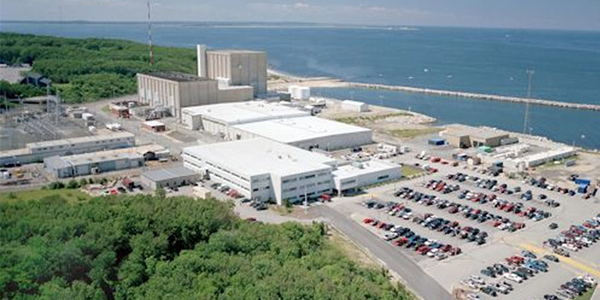By Rich Heidorn Jr.
The Northeast Power Coordinating Council (NPCC) is projecting a summer peak demand of 103,548 MW in the week of July 28, a 0.6% reduction (589 MW) from last year, despite growth in Ontario.

NPCC is the NERC regional entity for New England, New York, Ontario, Québec, New Brunswick and Nova Scotia. | NERC
“This continues an almost decade-long trend of overall flat or declining peak demand forecast due to energy efficiency and conservation initiatives, as well as the significantly increasing role of behind-the-meter PV resources in New England and New York,” NPCC CEO Edward Schwerdt said in a May 2 press release announcing the summer Reliability Assessment.
With the addition of 2,855 MW of net new capacity since summer 2018, NPCC forecasts a minimum operable capacity margin (spare operable capacity less transfer capability limitations) of 12,545 MW (12.2%) for the summer.
NPCC is the NERC regional entity for New England, New York, Ontario, Québec, New Brunswick and Nova Scotia. The U.S. represents 46% of NPCC’s net energy for load with Canada accounting for 54%. NPCC represents about 70% of Canada’s electric demand.
While New England and New York often hit their summer peaks together because of the proximity of their load centers, “there is some potential” for Ontario’s summer peak to occur at the same time, the report said. “Ambient weather conditions remain the most important variable in forecasting peak demand during the summer months,” it said.
The report included regional snapshots of the changes in generation since summer 2018 and the projected peaks for this year:
- New York added a net 127 MW, including 158 MW of wind, with 167 MW of coal generation retirements and 446 MW restored with the withdrawal of Selkirk 1 and 2’s mothball notice. NYISO projects a peak of 32,382 MW, a 522-MW drop from the summer 2018 forecast, because of state energy efficiency programs and the growth of BTM, including retail PV, combined heat and power, anaerobic digester gas, fuel cells and energy storage.
- New England added a net of 568 MW, including the dual-fuel Bridgeport Harbor expansion (510 MW), Canal 3 (333 MW) and Medway Peaker (208 MW). Wind and solar generation increased by 135 MW. Entergy’s Pilgrim nuclear plant (680 MW), Massachusetts’ only nuclear unit, is expected to retire by June 1. ISO-NE’s forecast peak is 25,323 MW, 406 MW below last year’s projection. The RTO cited demand reductions from energy efficiency, load management, passive demand response, distributed generation and BTM PV.
- Ontario’s generation increased by a net of 1,418 MW, including the Napanee gas-fired generator (985 MW), wind (375 MW), solar (98 MW) and hydro (16.4 MW). About 56 MW of gas-fired generation is retiring. Ontario’s Independent Electricity System Operator forecast a 103-MW increase in peak demand, to 22,105 MW. Conservation savings and distribution-connected generation are expected to partially offset increased demand from economic and population growth.
- Québec and the Maritimes, both winter-peaking areas, will see a slight increase, with Québec adding 38 MW of biomass and losing 8 MW of other generation for a net change of 30 MW. Québec is forecasting a 471-MW increase in the peak, to 21,005 MW. The Maritimes expect a peak of 3,255 MW, up 20 MW from last summer.

Transmission, Pipelines
Although NPCC expects spare operable capacity (capacity above reserve requirements) of 19,884 MW during its coincident peak the week of July 28, limited transfer capability from Québec and the Maritimes will reduce the amount available to the rest of its territory to 14,954 MW.
Since last summer, NYISO has added the Cricket Valley 345-kV substation — on the Pleasant Valley-Long Mountain 345-kV tie line with New England — to serve the new Cricket Valley combined cycle generating station expected to begin operation after the summer.
Unlike in winter, ISO-NE does not expect natural gas deliverability issues to affect generation. The RTO also can call on 340 MW of active demand resources on the peak.
The RE said it foresees “no significant likelihood” of implementing operating procedures for resource shortages (voltage reductions, and reductions of 10- and 30-minute reserves) during the summer for the expected peak load, a forecast based on the probability-weighted average of seven load levels simulated.
NPCC said operating procedures are available if needed to maintain reliability during severe system conditions and extreme heat simultaneously. The assessment also considered scenarios with extended unit maintenance; reductions in DR; reductions in the ability to import power from neighboring regions; transmission constraints; and widespread and prolonged heat waves with high humidity.
Geomagnetic Disturbances
The RE, which has had operating procedures since 1989 to respond to geomagnetically induced currents (GICs) from solar storms, said it expects “quiet levels” of solar activity for the summer.
“The solar coronal regions are stabilizing as the next solar minimum approaches, with fewer coronal holes and fewer extensions to lower solar latitudes that can sweep higher velocity solar winds toward the Earth,” NPCC said, while acknowledging that sunspot formations are difficult to predict.
While “these rogue events can and do occur,” the report said, “the odds of such an event during any particular week of the coming summer are very low.”



